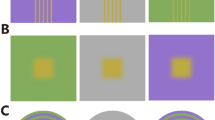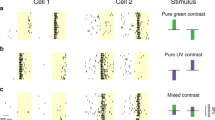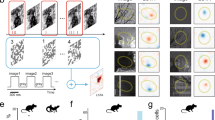Abstract
In natural scenes, chromatic variations, and the luminance variations that are aligned with them, mainly arise from surfaces such as flowers or painted objects. Pure or near-pure luminance variations, on the other hand, mainly arise from inhomogeneous illumination such as shadows or shading. Here, I provide evidence that knowledge of these color–luminance relationships is built into the machinery of the human visual system. When a pure-luminance grating is added to a differently oriented chromatic grating, the resulting 'plaid' appears to spring into three-dimensional relief, an example of 'shape-from-shading'. By psychophysical measurements, I found that the perception of shape-from-shading in the plaid was triggered when the chromatic and luminance gratings were not aligned, and suppressed when the gratings were aligned. This finding establishes a new role for color vision in determining the three-dimensional structure of an image: one that exploits the natural relationships that exist between color and luminance in the visual world.
This is a preview of subscription content, access via your institution
Access options
Subscribe to this journal
Receive 12 print issues and online access
$209.00 per year
only $17.42 per issue
Buy this article
- Purchase on Springer Link
- Instant access to full article PDF
Prices may be subject to local taxes which are calculated during checkout







Similar content being viewed by others
References
Lu, C. & Fender, D.H. The interaction of color and luminance in stereoscopic vision. Invest. Ophthalmol. 11, 482–489 (1972).
Gregory, R.L. Vision with isoluminant color contrast: a projection technique and observations. Perception 6, 113–119 (1977).
Ramachandran, V.S. & Gregory, R.L. Does color provide an input to motion perception? Nature 275, 55–56 (1978).
Rubin, J.M. & Richards, W.A. Color vision and image intensities: When are changes material? Biol. Cybern. 45, 215–226 (1982).
Livingstone, M.S. & Hubel, D.H. Psychophysical evidence for separate channels for the perception of form, color, movement, and depth. J. Neurosci. 7, 3416–3468 (1987).
Cavanagh, P. Vision at equiluminance. in Vision and Visual Dysfunction: Limits of Vision Vol. 5. (eds. Kulikowski, J.J., Murray, I.J. & Walsh, V.) 234–250 (CRC Press, Boca Raton, Florida, 1991).
Mullen, K.T. & Kingdom, F.A.A. Color contrast in form perception. in Vision and Visual Dysfunction: the Perception of Color Vol. 6. (eds. Gouras, P. & Cronly-Dillon, J.) 198–217 (Macmillan, Oxford, 1991).
Mollon, J.D. 'Tho' she kneel'd in that place where they grew...' The uses and origins of primate color vision. J. Exp. Biol. 146, 21–38 (1989).
Regan, D. Human Perception of Objects (Sinauer, Sunderland, Massachusetts, 2000).
Kingdom, F.A.A. & Simmons, D.R. The relationship between color vision and stereoscopic depth perception. J. Soc. 3D Broadcast. Imaging 1, 10–19 (2000).
Sumner, P. & Mollon, J.D. Catarrhine photopigments are optimised for detecting targets against a foliage background. J. Exp. Biol. 23, 1963–1986 (2000).
Gegenfurtner, K.R. & Rieger, J. Sensory and cognitive contributions of color to the recognition of natural scenes. Curr. Biol. 10, 805–808 (2000).
Domini, N.J. & Lucas, P.W. Ecological importance of trichromatic vision to primates. Nature 410, 363–365 (2001).
Fine, I., MacLeod, D.L.A. & Boynton, G.M. Surface segmentation based on the luminance and color statistics of natural scenes. J. Opt. Soc. Amer. A (in press).
Parraga, C.A., Troscianko, T. & Tolhurst, D.J. Spatiochromatic properties of natural images and human vision. Curr. Biol. 12, 483–487 (2002).
Ramachandran, V.S. Perception of shape from shading. Nature 331, 163–166 (1988).
Johnstone, A., Hill, H. & Carman, N. Recognising faces: effects of lighting direction, inversion and brightness reversal. Perception 21, 365–375 (1992).
Sun, J. & Perona, P. Shading and stereo in early perception of shape and reflectance. Perception 26, 519–529 (1997).
Lehky, S.R. & Sejnowski, T.J. Network model of shape-from-shading: neural function arises from both receptive and projective fields. Nature 333, 452–454 (1988).
Attick, J.J., Griffin, P.A. & Redlich, A.N. Statistical approach to shape from shading: reconstruction of three-dimensional face surfaces from single two-dimensional images. Neural Comput. 8, 1321–1340 (1996).
Switkes, E., Bradley, A. and DeValois, K.K. Contrast dependence and mechanisms of masking interactions among chromatic and luminance gratings. J. Opt. Soc. Amer. A 5, 1149–1162 (1988).
Cavangh, P., & Leclerc, Y. Shape from shadows. J. Exp. Psychol. Hum. Percept. Perform. 15, 3–27 (1989).
Knill, D.C., Kersten, D. & Mamassian, P. Implications of a Bayesian formulation of visual information for processing for psychophysics. in Perception as Bayesian Inference (eds. Knill, D.C. & Richards, W.) (Cambridge Univ. Press, Cambridge, UK, 1996).
Barlow, H.B. & Foldiak, P. Adaptation and decorrelation in the cortex. in The Computing Neuron (ed. Rosenblith, W.A.) 217–234 (MIT Press, Cambridge, Massachusetts, 1989).
Field, F.J. What is the goal of sensory coding? Neural Comput. 6, 559–601 (1994).
Simoncelli, E.P. & Olshausen, B.A. Natural image statistics and neural representation. Annu. Rev. Neurosci. 24, 1193–1216 (2001).
Knill, D.C. & Richards, W. Perception as Bayesian Inference (eds. Knill, D.C. & Richards, W.) (Cambridge Univ. Press, Cambridge, UK, 1996).
Acknowledgements
This research was supported by a Canadian Institute of Health Research grant (MOP-11554 to F.K.). Special thanks to D. Field and K. Mullen for suggestions on an earlier version of the manuscript.
Author information
Authors and Affiliations
Corresponding author
Ethics declarations
Competing interests
The author declares no competing financial interests.
Rights and permissions
About this article
Cite this article
Kingdom, F. Color brings relief to human vision. Nat Neurosci 6, 641–644 (2003). https://doi.org/10.1038/nn1060
Received:
Accepted:
Published:
Issue Date:
DOI: https://doi.org/10.1038/nn1060
This article is cited by
-
Perceiving the representative surface color of real-world materials
Scientific Reports (2023)
-
Quantifying the unquantifiable: the color of cinematic lighting and its effect on audience’s impressions towards the appearance of film characters
Current Psychology (2022)
-
On the purposes of color for living beings: toward a theory of color organization
Psychological Research (2015)
-
The Uses of Colour Vision: Ornamental, Practical, and Theoretical
Minds and Machines (2015)
-
The relative contributions of colour and luminance signals towards the visuomotor localisation of targets in human peripheral vision
Experimental Brain Research (2007)



